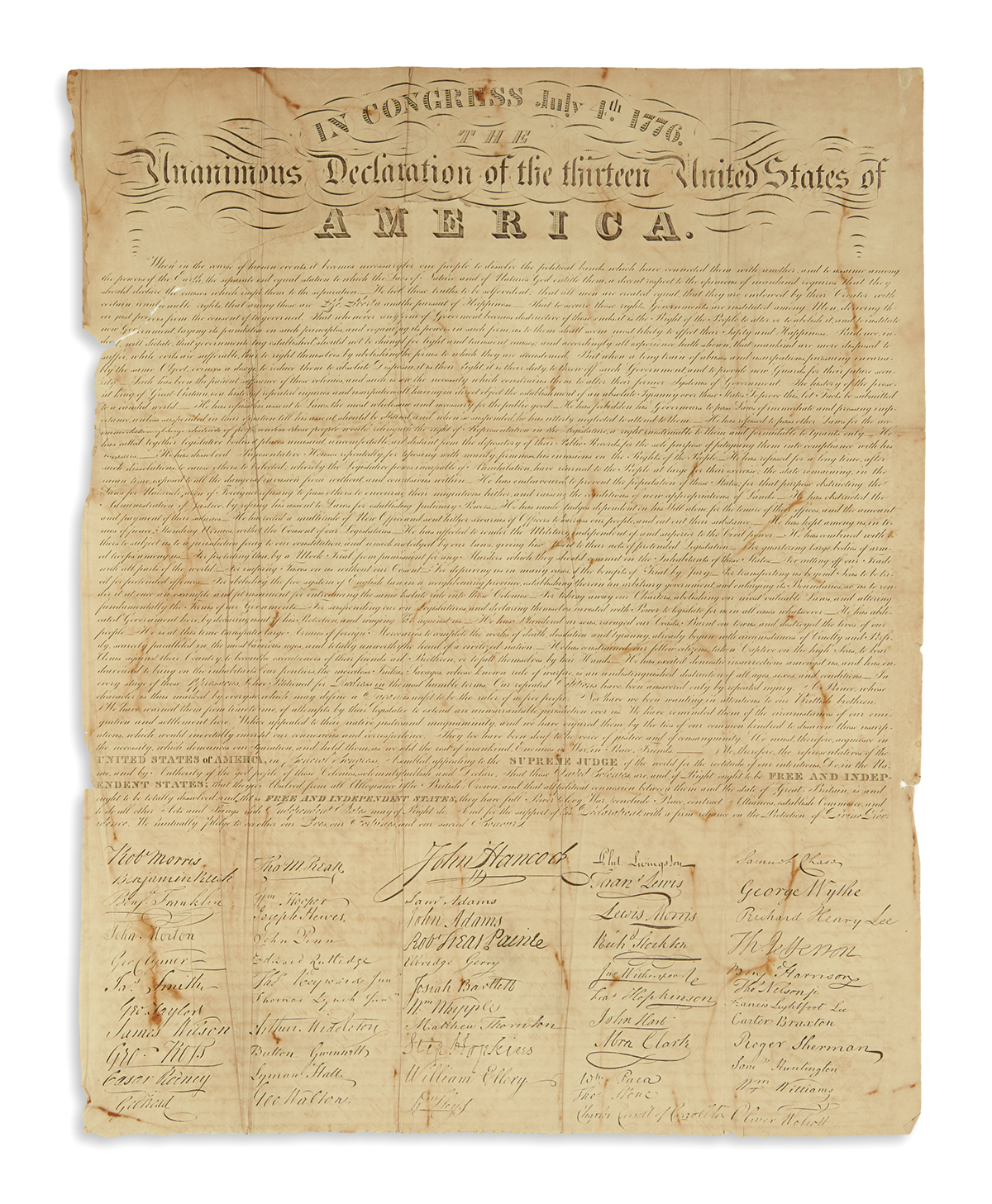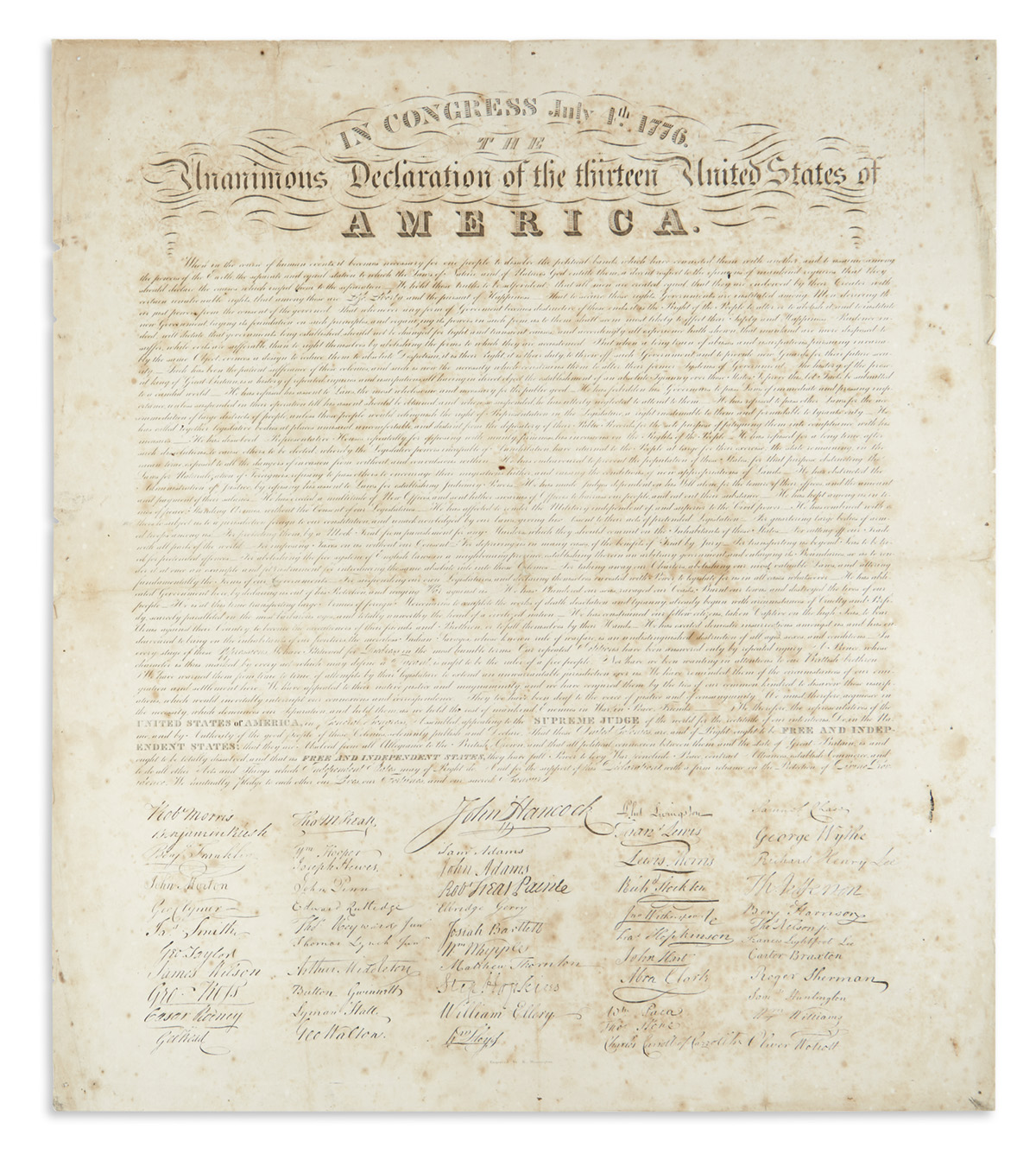Declaration of Independence — Eleazer Huntington (engraver)In Congress, July 4, 1776. The Unanimous Declaration of the Thirteen United States of America. [Hartford, Connecticut]: Eleazer Huntington, [1820-1824]
Engraved broadside (605 x 502 mm), printed on wove paper. Among the rarest broadside printings of the Declaration in the early 19th century.
According to John Bidwell's list, this is the sixth broadside edition of the Declaration of Independence. Bidwell locates only three copies of the Huntington printing of the Declaration: the Huntington Library, Massachusetts Historical Society, and American Antiquarian Society. The Declaration of Independence, the foundation document of the United States, has been printed numerous times since its original publication in 1776. At first as broadsides, then as an essential addition to any volume of laws, it was from the beginning a basic work in the American canon. The present document is one of the earliest broadside editions of the Declaration, done within a few years of the first broadside republications In the period following the war of 1812, Americans began to look back, for the first time with historical perspective, on the era of the founding of the country. The republic was now forty years old, and the generation which had taken part in the American Revolution, including the signers of the Declaration, was dropping away. With nostalgia and curiosity Americans began to examine the details of the nation's founding: documents such as the debates of the Constitutional Convention were published for the first time. Against this background it seemed extraordinary that the Declaration of Independence, as created, was unknown to Americans, when the text was so central to the national consciousness. Several entrepreneurs set out to bridge this gap by printing exact copies of the document, often featuring calligraphic text, portraits, or other decorative flourishes. The first to do so was a writing master named Benjamin Owen Tyler, who created a calligraphic version of the Declaration and published it in 1818, recreating exactly the signatures of the signers as they appeared on the original. Three other broadside printings of the Declaration were issued in 1818 and 1819, each containing ornamental borders or illustrations. These were followed in the early 1820s by the present printing by Hartford engraver and penmanship author Eleazer Huntington. He followed Tyler's example by creating a calligraphic facsimile of the Declaration, but stripped out the ornaments and illustrations that had been added by previous publishers, returning the document to the simple title and text of the original, and providing the signatures of the signers in exact facsimile. REFRENCES:John Bidwell, "American History in Image and Text" in Proceedings of the American Antiquarian Society, 1988, Vol. 98, pp.247-302 (also issued as a separate pamphlet by AAS), item 6
Declaration of Independence — Eleazer Huntington (engraver)In Congress, July 4, 1776. The Unanimous Declaration of the Thirteen United States of America. [Hartford, Connecticut]: Eleazer Huntington, [1820-1824]
Engraved broadside (605 x 502 mm), printed on wove paper. Among the rarest broadside printings of the Declaration in the early 19th century.
According to John Bidwell's list, this is the sixth broadside edition of the Declaration of Independence. Bidwell locates only three copies of the Huntington printing of the Declaration: the Huntington Library, Massachusetts Historical Society, and American Antiquarian Society. The Declaration of Independence, the foundation document of the United States, has been printed numerous times since its original publication in 1776. At first as broadsides, then as an essential addition to any volume of laws, it was from the beginning a basic work in the American canon. The present document is one of the earliest broadside editions of the Declaration, done within a few years of the first broadside republications In the period following the war of 1812, Americans began to look back, for the first time with historical perspective, on the era of the founding of the country. The republic was now forty years old, and the generation which had taken part in the American Revolution, including the signers of the Declaration, was dropping away. With nostalgia and curiosity Americans began to examine the details of the nation's founding: documents such as the debates of the Constitutional Convention were published for the first time. Against this background it seemed extraordinary that the Declaration of Independence, as created, was unknown to Americans, when the text was so central to the national consciousness. Several entrepreneurs set out to bridge this gap by printing exact copies of the document, often featuring calligraphic text, portraits, or other decorative flourishes. The first to do so was a writing master named Benjamin Owen Tyler, who created a calligraphic version of the Declaration and published it in 1818, recreating exactly the signatures of the signers as they appeared on the original. Three other broadside printings of the Declaration were issued in 1818 and 1819, each containing ornamental borders or illustrations. These were followed in the early 1820s by the present printing by Hartford engraver and penmanship author Eleazer Huntington. He followed Tyler's example by creating a calligraphic facsimile of the Declaration, but stripped out the ornaments and illustrations that had been added by previous publishers, returning the document to the simple title and text of the original, and providing the signatures of the signers in exact facsimile. REFRENCES:John Bidwell, "American History in Image and Text" in Proceedings of the American Antiquarian Society, 1988, Vol. 98, pp.247-302 (also issued as a separate pamphlet by AAS), item 6









Try LotSearch and its premium features for 7 days - without any costs!
Be notified automatically about new items in upcoming auctions.
Create an alert